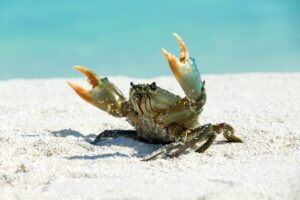It all begins with a nibble on your line. A few strong tugs and your heart beats a bit faster anticipating that something delicious beneath the waves has taken the bait. Who knows what could land on the hook when you drop a line into Chesapeake waters?
The Bay shelters about 350 fish species, which presents a cornucopia of regional seafood. Whether you’re trolling on the back of your boat or casting from a wooden pier, get ready to reel in a plentiful catch. With 11,684 miles of shoreline surrounding America’s premier estuary, the possibilities are endless.
During the summer, three candidates are likely to land in your cooler: crabs, rockfish and catfish. Once you catch them, how do you cook them? To help you prepare local delicacies like a waterman’s wife, Marinalife talked to Eric Rosen, owner of St. Michaels Crab & Steak House, who has spent nearly a quarter-century preparing seafood Chesapeake-style.
His restaurant is located at St. Michaels Marina, so he’s a pro at showing boaters how to make feasts with big flavors in small spaces. “Fresh and simple is the key,” says Rosen about Chesapeake cuisine. “With seafood pulled right from the water, you don’t need to do much to create a memorable meal.”
With a few cooking essentials on board — 3-to 5-gallon pot, a frying pan, a bucket for discarded shells, newspapers, cooking oil and a can of Old Bay or J.O. seasoning — you can whip up a tasty dish to satisfy your crew.
Steam Crabs Like You Were Born in Baltimore
Picnic tables covered with newspaper and piles of discarded shells, accompanied by wooden mallets smacking stubborn claws, represents a beloved summer ritual on the Bay. While licking rust-colored seasoning off their fingers, locals cherish the tradition of picking this iconic crustacean.
What makes Chesapeake crabs special? Some say the Bay’s brackish water enhances their flavor. Others argue that cold winter temps force crabs to develop insulating fat that makes them sweeter than their Southern counterparts. Their season lasts from April to December and peaks in late summer when crabs grow plump and sweet.
Steaming crabs is easy, and a few basic rules ensure an authentic Bay experience. “If they’re not kicking,” says Rosen, “we don’t cook them. When they’re alive, you know they’re fresh and safe to eat.” Locals turn up their noses at boiled crabs, claiming that submerging them in water makes them soft and mushy. Steaming is preferred, because it locks in the flavor.
Some folks add a splash of beer or vinegar to the boiling water, but everyone shakes a hefty amount of Old Bay or J.O. Spice on top. A dozen crabs steamed in a 3- to 5-gallon pot with a tight lid take about 20 to 25 minutes. When their color changes from blue to red, it’s time for picking. Favorite sides at Bay crab feasts include hush puppies, fries, coleslaw, corn on the cob and cold beer or orange crushes.
The One-Pan Solution for Flawless Rockfish
When you pull in a fish with dark racing stripes across its sides, you’ve landed a sea creature so beloved in the region that it’s Maryland’s official state fish. Technically, it’s called rockfish in salt waters and striped bass in fresh waters, but locals don’t fuss much over the name. This feisty fish is fun to catch and a treat to eat.
Rockfish cruise the Bay year-round but head north in the spring to spawn in fresh water. During the 1990s, their population dipped so low that authorities imposed size and catch limits. Reel in two and you’re done, and rockfish must be at least 18 inches long to keep.
From lip to tail tip, the average rockfish measures about two to three feet, yielding a pair of nice-sized fillets. “Less is more,” notes Rosen when cooking rockfish. “You don’t want to mask the delicate flavor of this mild fish by adding heavy doses of seasoning.”
He keeps it simple by lightly pan-frying them with butter, lemon and a splash of white wine. Broiling with Old Bay sprinkled on top works well, too. Stuffing crab meat inside rockfish fillets is a heavenly taste experience. On the side, try fresh vegetables, rice or garlic pasta, washed down with a crisp Chardonnay.
A Dash of Heat Delivers Purr-fect Catfish
Eating seafood can improve the Bay’s environment, especially when you take a fork to blue catfish. This invasive species started swimming around Virginia’s James and Rappahannock rivers in the 1970s and is gobbling up native aquatic life as far north as the Potomac. They breed like crazy and have few natural predators, so locals worry about their impact on the region’s ecosystem.
The average blue catfish is two feet long. It’s got a face that only a mother catfish could love, with four whiskers, pasty blue skin and beady little eyes. But, behind the ugly mug are tasty fillets that are mild and tender.
Two schools of thought suggest ways to skin catfish after snipping off its whiskers. Some folks fillet them like any other fish, slicing behind the gills and down the back. Others nail the tail to a wooden board and pull the meat from the skin. With two fillets in hand, Rosen dusts them with Cajun seasoning and tosses them on a hot grill. Each side takes about five minutes, and then you can devour the invader. Another tasty option: Cut the fillets into strips, dredge them in bread crumbs, cornmeal or our and quick-fry them in vegetable oil for a crispy finish.





